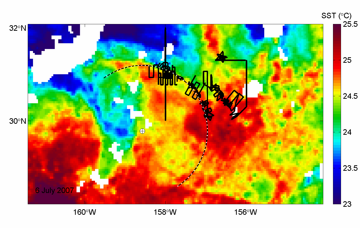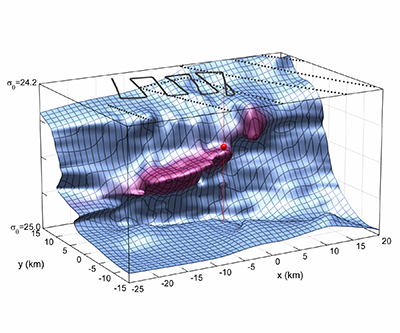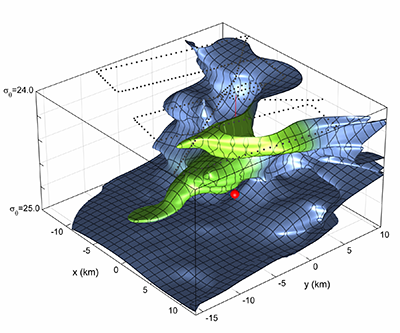Thermohaline intrusions are formed by localized penetration of one water mass into another (typically across a front). The term "intrusions" is traditionally reserved for the features of limited vertical extent which are still attached to their water mass of origin. (Other examples of mutual water mass penetration being filaments, lenses, eddies, etc.)
Frontal intrusions are one of the crucial building blocks of lateral dispersion of heat, salt, nutrients, and other tracers in the ocean.
Objectives
- Locate intrusions and determine their cross-front characteristics
- Determine the 3D structures of intrusions and how they relate to the front
- Follow the evolution of several intrusions in a Lagrangian frame
- Observe the formation of one or more intruions
Cruise
(See the map on the right or explore it interactively with Google Earth (plugin required) or Google Maps.)A field study of the interleaving features in the Subtropical Frontal Zone (STFZ) of the North Pacific near 31°N, 158°W was conducted from 5 to 29 July 2007 onboard the R/V Wecoma.
This "STF07" experiment encompassed:
- Hydrographic surveying with a towed depth-cycling conductivity-temperature-depth (CTD) platform SWIMS
- Microstructure profiling
- Shipboard velocity observations
- Lagrangian float releases
Intrusions
During the STF07 experiment, we mapped three-dimensional structure of several prominent intrusions. Particular shapes observed included broad sheets and narrow tongues, extending towards the warm and salty side of the thermohaline fronts:
The structure of the intrusions is better seen in the "fly-over" of the isohaline surfaces (below). Note how the deformation of the middle (35.0) isohaline surface forms a "broad-sheet" intrusion:




